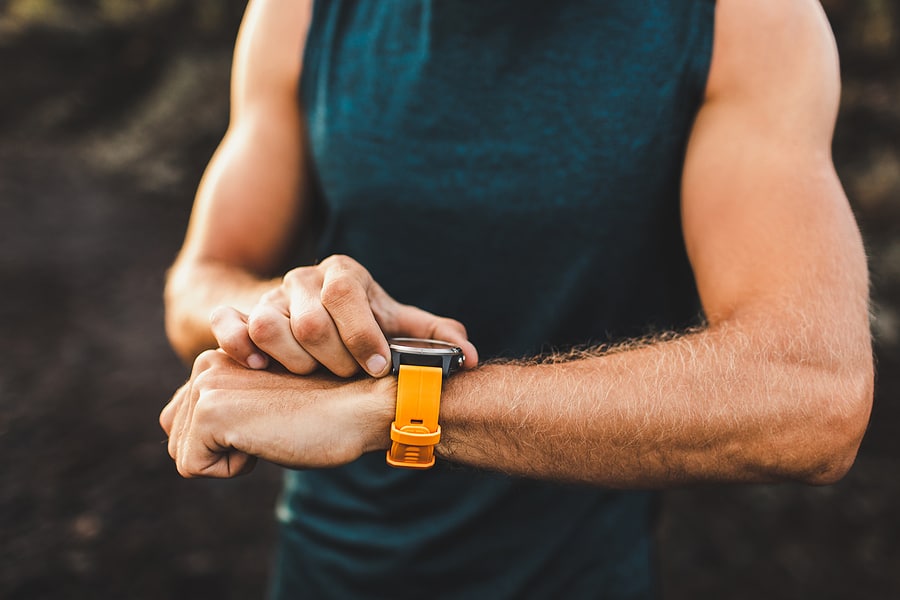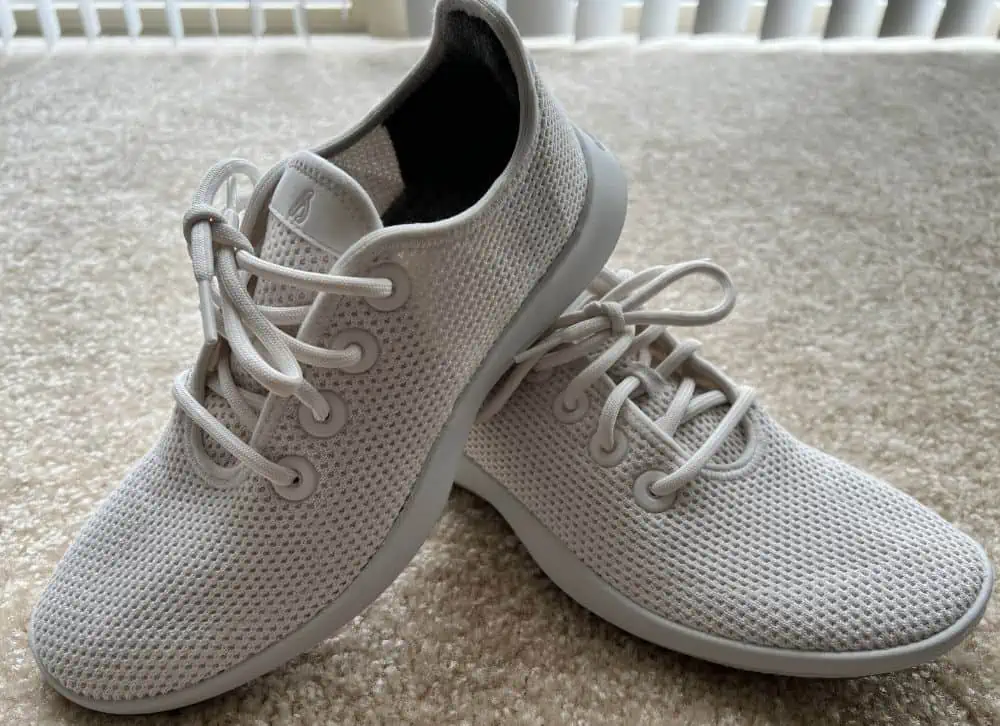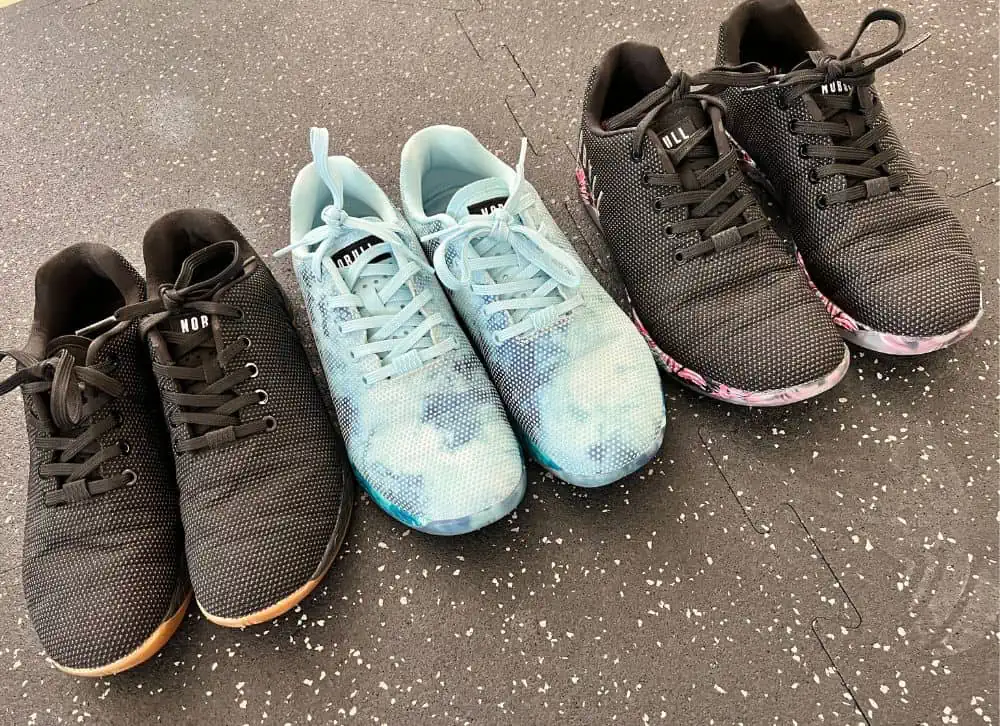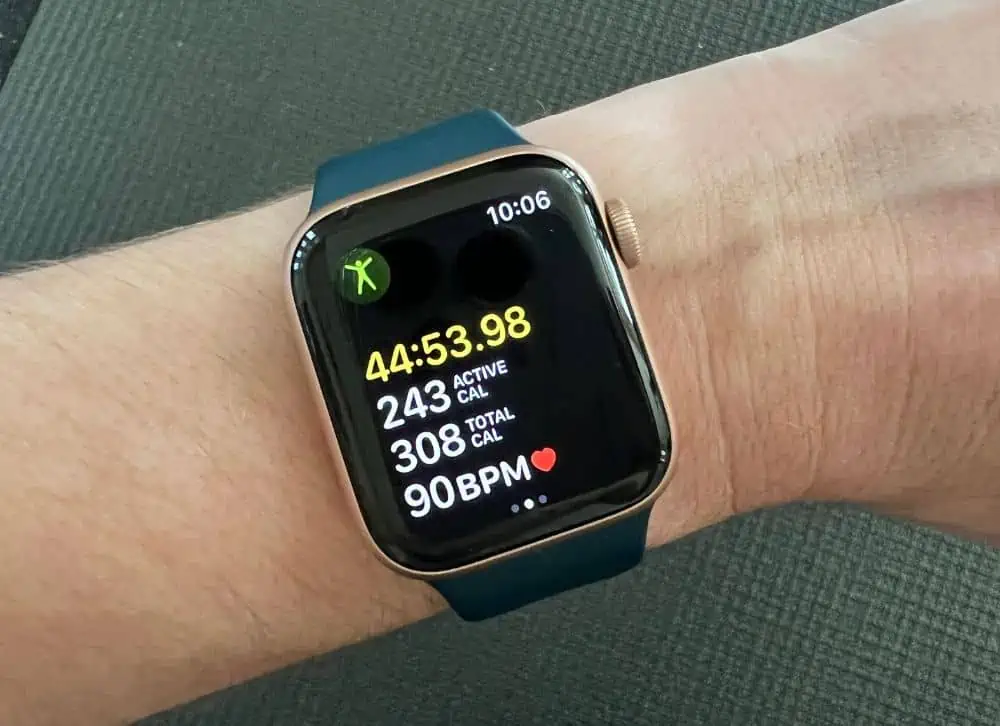This post may contain affiliate links. If you click through a link and make a purchase, I may receive a commission at no additional cost to you. As an Amazon Associate, I earn from qualifying purchases. Read the full disclosure here.
Wearable tech is becoming extremely popular. It seems like everyone has an activity tracker these days.
You’re probably here because you’re considering taking the plunge into the fitness tracker club. (Welcome!)
Are fitness trackers worth it? Or will it just end up in a junk drawer with a bunch of your old cell phones?
Not all technology is created equal, and features are constantly improving.
Buckle up, because we’re going to take a ride through the pros, cons, and benefits of fitness technology in this ultimate guide to fitness trackers to help you decide what’s best for you!
- My experience with fitness watches
- Why do I need a fitness tracker?
- Benefits of fitness trackers
- Disadvantages of fitness watches
- Fitness tracker features to consider
- How do fitness trackers work?
- Are fitness trackers accurate?
- Accuracy concerns of fitness trackers
- Questions to consider when shopping for a wearable tracker
- Which fitness trackers are the best?
- What else can affect heart rate?
- How to measure intensity if your fitness tracker isn’t cooperating
- Can’t I just track my steps?
- Can fitness trackers actually improve your fitness?
- Are fitness trackers worth it?
Disclaimer: This content is for educational purposes and is not medical advice. Read the full disclaimer.
My experience with fitness watches
If you’ve been reading for a while, you probably know that I love fitness watches.
My first fitness watch was a Polar watch and chest-worn heart rate monitor; we’ll call it circa 2006 (before they were cool). Fifteen+ years later, I’ve pretty much never exercised without it.
Well, not the same one. I’ve run through quite a few fitness watches since 2006. And yes, I’ve tested some of them at the same time to compare, inviting curiosity from fellow gym members as a walking advertisement for fitness tech.
For me, I want the most accurate data in real time. There’s a certain sense of accomplishment in seeing the value behind my hard work, in the form of heart rate and calories. It helps boost my motivation and gives me a goal to strive for that day.
Nothing irritates me quite like a fitness tracker searching for a heart rate for several minutes while I’m busting my butt, only to find it after and get no credit for the burst of intensity, (such as during a HIIT workout.)
I did the work, but still…Exercising without my watch kind of just feels like shouting into a void.
But enough about me, let’s get into why you’re here.
Why do I need a fitness tracker?
Let’s talk about why you might want to consider a wearable fitness tracker in the first place.
The updated physical activity guidelines focus on time and intensity of exercise for overall health benefits.
Recommended physical activity guidelines for active adult populations:
- Sit less, move more.
- Even small increases in activity provide health benefits.
- For substantial health benefits, at least 150-300 min (2.5-5 hrs) of moderate-intensity aerobic physical activity per week.
- Or, at least 75-150 min (1.25-2.5 hrs) of vigorous-intensity aerobic physical activity per week.
- Strengthening for all major muscle groups (mod intensity or greater) at least 2 days per week.
- Additional health benefits gained beyond 300 min per week.
- Include flexibility exercises (these don’t count toward the 150 min)
How to measure exercise intensity
Intensity is measured via heart rate or perceived exertion.
We’ll be focusing on heart rate measurement and how fitness trackers can make this super easy.

Benefits of fitness trackers
Depending on the device, benefits may include:
- Help you identify and set fitness goals (weight loss, caloric expenditure, daily activity/step count, etc.)
- Assist with accountability and reminders to meet daily goals and reach that minimum of 150 minutes per week
- Suitable for any fitness level
- Monitor heart rate, calories, type and duration of exercises, and step count with a convenient wearable device
- Track your daily activity level
- Integrate with training programs such as couch to 5K
- Increase motivation
- Sleep tracking metrics (e.g. sleep pattern, sleep quality, etc.)
- Connect with an app (e.g. the Fitbit app if you have a Fitbit device) to receive smartphone notifications
- Compare fitness data over time
- Group challenges with friends for the competitive folks
- Multiple options at various price points from basic fitness trackers to smartwatches
- Provide a sense of accomplishment for your fitness routine
- They’re fun!
Disadvantages of fitness watches
- You still have to BYO motivation
- Questionable accuracy with heart rate tracking for wrist-worn tech
- Battery life (yet another thing to charge)
- Pricey – the entry point for a basic activity tracker is around $100, and skyrockets when you start talking about smartwatches.
- Fitness trackers don’t magically change the basics. They’re only part of the whole fit lifestyle equation, you still need to watch your nutrition, make healthy choices, etc.
- Wrist-worn tech needs to be worn all the time if you want all of the data.
Fitness tracker features to consider
There are so many options when shopping for fitness trackers, it’s easy to get caught up in shiny object syndrome.
Consider the features that are actually important to you. This is a list of common features in no particular order.
- Price point
- Heart rate monitoring (wrist-worn vs. chest-strap)
- Size of the watch
- Bluetooth
- Compatibility with Iphone and Android smartphones
- Integration with native or third-party apps
- Smartwatch notifications
- Aesthetic look / interchangeable bands
- GPS tracking
- Sleep tracking
- Waterproof
- Battery life
- Altimeter
- Music storage and controls
- LTE connectivity
- Durability
- 3-axis accelerometer
How do fitness trackers work?
To avoid garbage-in-garbage-out, let’s take a look at how fitness trackers actually work to pick the best features for you.
Chest-worn technology
Chest-worn technology mimics telemetry and is the gold standard for heart rate monitoring in fitness.
For each heartbeat, electrical impulses are transmitted through the heart. Chest-worn monitors pick up these electrical signals through the skin and transmit that data to a paired watch giving real-time heart rate feedback.
Pros of chest-worn tech
With accuracy similar to EKG, chest-worn monitors are still considered the gold standard for heart rate tracking during fitness.
Because heart rate is part of the calorie equation, total calories burned during exercise may be more accurate.
Cons of chest-worn tech
Requires wearing a chest monitor and watch, so this isn’t something you would wear all day for activity tracking.
For women, a chest strap usually fits neatly at the base of a sports bra and hardly bothers. For men, this can be more of a nuisance.
Wrist-worn technology
Wrist-worn technology tracks heart rate via an optical sensor.
The down and dirty physics of this heart rate sensor work by flashing a green light into the skin and measuring the light that bounces back.
Blood pumping through the arteries will absorb more green light, refracting less light back to the wrist tracker, translating into beats per minute.
This fancy process is called photoplethysmography.
Say that three times fast!
Pros of wrist-worn tech
Convenient – always on you and ready to track activity at a moment’s notice.
Cons of wrist-worn tech
Variable accuracy (more below).
Requires frequent recharging. This varies by brand but can be anywhere from every day to once a week.
Are fitness trackers accurate?
Perhaps, the most important question. Exactly how accurate are fitness trackers?
Let’s take a look at what the research says.
- Accuracy varies by device and activity. There are limitations with wrist-worn technology.
- Monitors using a chest strap are still the most accurate.
- For some activities, one study demonstrated wrist-worn device readings vary +/- 15-34 bpm.
- Up to 27% error on calories burned has been recorded.
- Wrist-worn devices found to be more accurate with rhythmic activities such as walking or running and less accurate with more erratic movements such as during a kickboxing class.
- Shcherbina, A. et al. found higher device error with increased body mass, darker skin tones, and the presence of tattoos on the wrist, heavy arm hair, or sweat.
Though these studies are recent, technology is constantly changing. First and second-generation tech has a lot of kinks to work out.
Newer generations of fitness trackers are already proving to up their game.
It will be interesting to see what future studies have to say.
Accuracy concerns of fitness trackers
It’s important for some populations such as those with cardiovascular disease, pregnancy, or serious athletes to have an accurate, real-time reading.
Heart rate is also a component of the calorie math equation. When the heart rate is not accurate, calorie burn is not accurate.
Other components of calories burned are gender, age, weight, and length of the exercise session.
If one of these measurements is off, it will skew the rest of the data.
Two people can do the exact same workout and have drastically different “calories burned” because of the differences in those factors.
If you’re tracking calories, accuracy will be important to you.
Questions to consider when shopping for a wearable tracker
What data is important to you? Are you looking for very accurate heart rate and calories? Or are ballpark stats and steps good enough.
What types of workouts do you do? Fitness trackers can be less accurate for some activities that aren’t rhythmic motions. Do you need your activity tracker to be waterproof?
How much do you want to spend? Activity trackers come in many price points, all the way up to smartwatches that cost several hundred dollars. Features and functionality tend to increase with the price so it depends on what you’re looking for.
Which fitness trackers are the best?
I wouldn’t recommend a fitness tracker that doesn’t at least have heart rate monitoring capabilities.
If you’re data-obsessed with a need for real-time accuracy, a chest-worn monitor paired with a fitness watch won’t disappoint. Look for a watch with Bluetooth capability to pair with a Polar H10 chest-worn monitor.
Best basic fitness trackers
Entry level fitness trackers that won’t break the bank with solid functions
Best fitness & cross-training
Best fitess watches for runners
Best smart watch
Samsung Galaxy Watch
Best bluetooth chest-worn monitor
I pair my Apple watch SE with a Polar H10.
I get the benefit of all-day activity tracking plus integration with my phone, as well as accurate heart rate monitoring during workouts.
You can read about why I think this is one of the best combinations for heart rate monitoring in this article.
And if I’m doing something like Yoga, Pilates, or casual walks, I can just utilize the wrist-worn tracking functionality.

What else can affect heart rate?
Other considerations to be aware of that might affect heart rate and ability to get an accurate reading (no matter what method you’re using):
- Medications (cardiac, antidepressants, asthma, cough/cold/allergy, thyroid medication, supplements)
- Cardiac Arrhythmias
- Dehydration/Fatigue
- Environment Conditions (heat/humidity/cold)
- Posture/positioning
- Illness
- Insufficient sleep/nutrition/recovery
- Caffeine
- Emotions (anxiety, stress, etc.)
How to measure intensity if your fitness tracker isn’t cooperating
Utilize RPE (rate of perceived exertion).
Perceived exertion is how hard you think you’re working. This is usually measured on a 1-10 scale, 1 being extremely light and 10 being hardest work. Moderate intensity falls around 4-6. High-intensity is considered 7-9+.
The other super-easy way is by using the talk test.
At low intensities, it should be very easy to talk. At moderate intensities, it should be more difficult to carry a conversation as your heart rate rises. At high intensities, it will be difficult to manage more than a few words.
Can’t I just track my steps?
Ah, the old 10,000 steps.
What if I told you this number wasn’t actually rooted in science and just caught on since the 1960s with a Japanese pedometer?
While it’s true that 10,000 steps means you moved more than if you took 5,000 steps, it reflects nothing about the quality or intensity of your movement.
It’s not an accurate measure of fitness.
It’s somewhat arbitrary and includes no indication you’ve elevated your heart rate; which is necessary to reap the cardiovascular benefits of exercise.
Not all steps are created equal.
There’s a big difference between attaining that goal from running 3 miles and moseying at a glacial pace. 10,000 steps means you moved; but it doesn’t tell you how well you moved.
Steps aren’t everything.
What if I took 6,000 steps in a day, but also did an 8-mile bike ride that my fitness tracker didn’t give me step credit for? Does that make me less fit because I didn’t get to 10,000 steps?
Of course not!
While you didn’t get step credit, you logged exercise time and added to your total calories burned for the day.
Steps are only a small piece of the movement equation. Focusing only on steps distracts from what you should be focusing on:
- Quality over quantity
- Time and intensity of exercise
- Cardiovascular exercise
- Strength training
- Flexibility and mobility
- Balance exercises
It’s not bad to track steps, you just can’t focus only on steps or you’re missing the point.
Tracking steps is likely to be more beneficial for extremely sedentary individuals at the start of a fitness program.
Sedentary is considered less than 5,000 steps per day. Greater gains are likely to be seen in someone going from 2,000 steps per day to 5,000 steps per day than 10,000 to 12,000.
Wrist-worn fitness trackers are also more likely to overestimate daily step counts due to everyday arm motions registering as steps.
Can fitness trackers actually improve your fitness?
Yes and no.
Unfortunately, no fitness device can make you more fit.
They can assist along your journey with various features, but you have to show up and bring your why and motivation with you.
Related Read: Questions You Should Be Asking to Reach Your Fitness Goals
Are fitness trackers worth it?
Fitness trackers are a fun sidekick to your workout routine. They can provide unique insight and assist you with your fitness goal.
There are many styles of wearable activity trackers at various price points to fit your activity needs.
If that long list of benefits appeals to you, then a fitness tracker is worth it. The best fitness tracker for you is one that’s fun to use and supports your goals.
Remember, a fitness tracker doesn’t magically change the basics and you still have to BYO motivation.
Happy fitness tracking!
featured image credit: brizmaker / bigstockphoto.com
References
Cadmus Bertram L.A., Marcus B.H., Patterson R.E., Parker B.A., Morey B.L. (2015). Randomized Trial of a Fitbit Based Physical Activity Intervention for Women. American Journal of Preventative Medicine. 49(3):414-8. doi: 10.1016/j.amepre.2015.01.020
Gillinov AM, Etiwy M, Gillinov S, Wang R, Blackburn G, Phelan D, Houghtaling P, Javadikasgari H. (2017) Variable Accuracy of Commercially Availiable Wearable Heart Rate Monitors. Journal of the American College of Cardiology. March, 69 (11 Supplement) 336. DOI: 10.1016/S0735-1097(17)33725-7
Reed J.L., Pipe A.L. (2014) The talk test: a useful tool for prescribing and monitoring exercise intensity. Current Opinion in Cardiology. 29(5):475-480. doi: 10.1097/HCO.0000000000000097
Sartor, F., Papini, G., Cox, L., & Cleland, J. (2018). Methodological Shortcomings of Wrist-Worn Heart Rate Monitors Validations. Journal of medical Internet research, 20(7), e10108. doi:10.2196/10108
Shcherbina, A., Mattsson, C. M., Waggott, D., Salisbury, H., Christle, J. W., Hastie, T., Ashley, E. A. (2017). Accuracy in Wrist-Worn, Sensor-Based Measurements of Heart Rate and Energy Expenditure in a Diverse Cohort. Journal of personalized medicine, 7(2), 3. doi:10.3390/jpm7020003
Stahl S.E. An H, Dinkel D.M., et al. (2016) How accurate are the wrist-based heart rate monitors during walking and running activities? Are they accurate enough? BMJ Open Sport & Exercise Medicine. 2:e000106. doi: 10.1136/bmjsem-2015-000106
United States Department of Health and Human Services. (2018). Physical Activity Guidelines for Americans, 2nd edition [PDF file]. Retrieved from https://health.gov/paguidelines/second-edition/pdf/Physical_Activity_Guidelines_2nd_edition.pdf






Great article, very thorough and honest. I use my Garmin Vivoactive daily. I don’t use it to track steps or sleep, but it is capable of that. I use it to track my running and walking. I do like it, but I like my husbands Garmin Forerunner 35 better. His can do intervals in time or distance. I need that for my speed workouts.
This is a cool collection of fitness trackers and fitness tips. Thank you for sharing 🙂
Oh wow, I can’t remember the last time I wore a fitness tracker. Maybe back in high school? I really want to get back into exercising a bit more so this has been very helpful to figure out what fitness tracker would work best for me this year. Thanks for sharing – Josie xxx
This has made me want to get back on track with wearing my Fitbit. Thanks!
I love my fitness tracker I wear it everyday